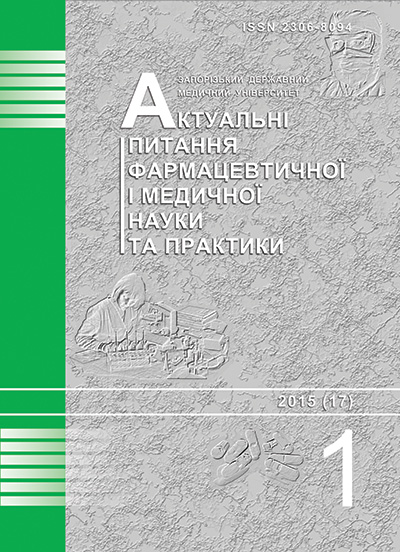THE CREATION OF NEWINTRANASALDRUGBASED ONRAW MATERIALSOF NATURAL ORIGINFORALLERGICRHINITISCOMBINED THERAPY
DOI:
https://doi.org/10.14739/2409-2932.2015.1.41392Keywords:
Intranasal Drug Administration, Allergic RhinitisAbstract
Allergic rhinitis is a disease of the nasal mucosa, which is based on allergic inflammation caused by the action of different natureallergens. Allergic rhinitis is quite common among the population, often occurs with frequent complications, resulting in decreased performance and quality of patients’life. Late or not effective therapy for this disease can lead to chronic disease and a combination of other pathologies, such as sinusitis, asthma and others.
Primarily due to allergic inflammation in the lining of the nasal cavity,the allergen may persist for several weeks after exposure. Inflammation in the nasal cavitylining, triggered by allergens, leads to the accumulation of eosinophils, dendritic cells, T-lymphocytes and epithelial cells, which in its turn leads to activation and increased production of adhesion molecules by endothelial cells.
Therapeutic help with allergic rhinitis may have the following areas:
a) mechanical evacuation allergens;
b) the use of pharmacological agents aimed at suppression of allergic process;
c) the use of allergen-specific therapy;
d) rational combination of the above directions for proper effect.
Aim. Hold technological characteristics of salt dosage forms which are used as evacuation agents in the treatment of allergic rhinitis.
Materials and methods. The material is known formulation, namely nasal saline solution. Information was taken from thesis, articles, patents and dissertation, etc.
Results and discussion.Evacuation direction of curative care in allergic rhinitis caused by necessity of mechanical removal of allergens from the nasal cavity mucous areas. To do this, salt solutions of different compositionare used. According to the UkrainianState Register of medicines,salineis most common medicine in the domestic market amongpharmacotherapeutic group "means used for diseases of the nose". Range of nasal dosage forms is dominated by imported drugs, the share of domestic drugs is only 31.25%. As active ingredients, saline manufacturers mostly use sodium chloride, seawater and complex trace elements (magnesium, sodium, calcium) in different ratios. Such intranasal solutions by nature are mostly hypo or isotonic drugs. An exception is Aqua Maris® Strong (producer of "Jadran" Galenic Laboratory, Croatia), which is hypertonic solution of sterile seawater. As the solvent purified water or water for injectionare used. To ensure the stability of nasal dosage forms, some manufacturers of the tracks added preservatives, derivatives of quaternary ammonium compounds (benzalkonium chloride) and aromatic alcohols (benzyl alcohol). To normalize the pH substances of different chemical nature, such as sodium hydrogen phosphate dihydrate, sodium dihydrogen phosphate dihydrate, hydrochloric acidare used.
Despite the existing range of drugs aimed at treatment and prevention of allergic rhinitis in patients,there is currentlyno safe and effectivetool that can fully provide therapeutic effect. When developing new means for intranasal pharmacotherapy of allergic rhinitis it is rational touse minerals of national origin, which will not only provide evacuation allergens, but also due to its high quality components will implement anti-inflammatory activity.
Conclusions. As a result of research it was conducted that among intranasal medicines the natural salt is used for the treatment and prevention of allergic rhinitis. It is established that complex magnesium minerals from raw materials of natural originare perspective to be used.
References
Braslavsky, V. E., Safrygin, K. V., & Ezova, O. A. (2003). Nazal'nyj sprej Akva Maris v kompleksnoj terapii kruglogodichnogo allergicheskogo rinita [Aqua Maris nasal spray in combined therapy of perennial allergic rhinitis]. Allergologiya, 4, 40–41. [in Russian].
Drobik, O. S., & Nasunova, A. Yu. (2013) Allergicheskij rinit – sovremennye podkhody k terapii [Allergic rhinitis – current therapy approaches]. E`ffektivnaya farmakoterapiya, 21, 18–24. [in Russian].
Garavello, W., Romagnoli, M., & Gaini, R. M. (2005) Hypertonic or isotonic saline for allergic rhinitis in children. Pediatr Allergy Immunol, 16, 91–92. doi: 10.1111/j.1399-3038.2005.00215.x.
Solelhac, G., & Charpin, D. (2014) Management of allergic rhinitis. F1000Prime Rep., 6, 94.
Chusakul, S., Warathanasin, S., Suksangpanya, N., Phannaso, C., Ruxrungtham, S., Snidvongs, K., & Aeumjaturapat, S. (2013). Comparison of buffered and nonbuffered nasal saline irrigations in treating allergic rhinitis. Laryngoscope, 123(1), 53–56. doi: 10.1002/lary.23617.
Informatsiino-poshukova systema «Derzhavnoho reiestru likarskykh zasobiv Ukrainy». Retrieved from http://www.drlz.kiev.ua.
Downloads
How to Cite
Issue
Section
License
Authors who publish with this journal retain copyright and grant the journal right of first publication with the work simultaneously licensed under a Creative Commons Attribution License that allows others to share the work with an acknowledgement of the work's authorship and initial publication in this journal.


